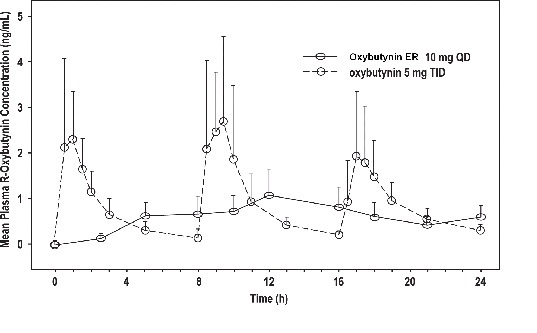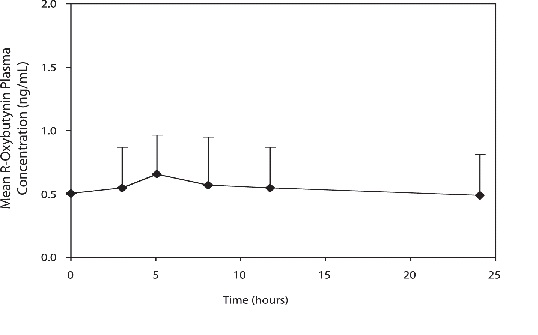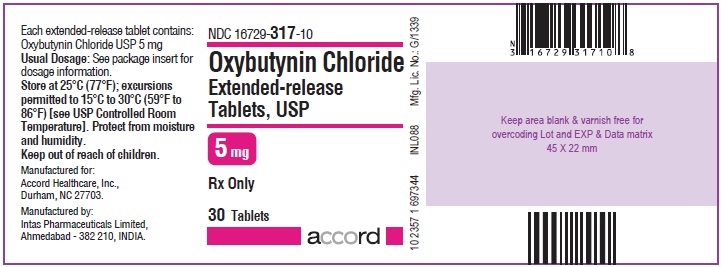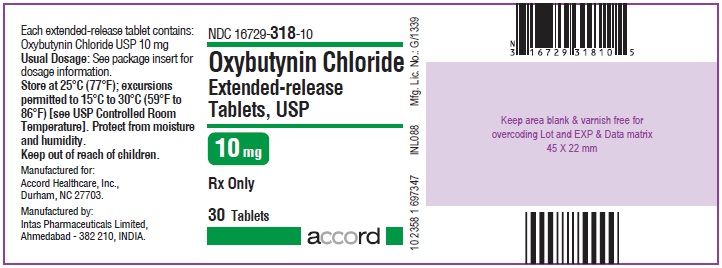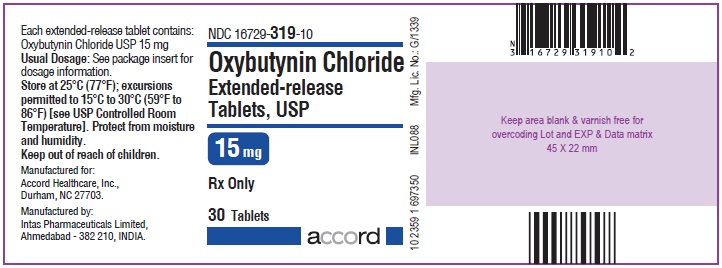OXYBUTYNIN CHLORIDE tablet, extended release
oxybutynin chloride by
Drug Labeling and Warnings
oxybutynin chloride by is a Prescription medication manufactured, distributed, or labeled by Accord Healthcare, Inc., Intas Pharmaceuticals Limited. Drug facts, warnings, and ingredients follow.
Drug Details [pdf]
-
HIGHLIGHTS OF PRESCRIBING INFORMATION
These highlights do not include all the information needed to use OXYBUTYNIN CHLORIDE EXTENDED-RELEASE TABLETS safely and effectively. See full prescribing information for OXYBUTYNIN CHLORIDE EXTENDED-RELEASE TABLETS.
OXYBUTYNIN CHLORIDE extended-release tablets, for oral use
Initial U.S. Approval: 1975INDICATIONS AND USAGE
- Oxybutynin chloride extended-release tablets are a muscarinic antagonist indicated for the treatment of overactive bladder with symptoms of urge urinary incontinence, urgency, and frequency. ( 1)
- Oxybutynin chloride extended-release tablets are also indicated for the treatment of pediatric patients aged 6 years and older with symptoms of detrusor overactivity associated with a neurological condition (e.g., spina bifida). ( 1)
DOSAGE AND ADMINISTRATION
Oxybutynin chloride extended-release tablets must be swallowed whole with the aid of liquids, and must not be chewed, divided, or crushed. Oxybutynin chloride extended-release tablets may be administered with or without food. ( 2)
DOSAGE FORMS AND STRENGTHS
Extended release tablets 5 mg, 10 mg and 15 mg ( 3)
CONTRAINDICATIONS
WARNINGS AND PRECAUTIONS
- Angioedema: Angioedema has been reported with oxybutynin. If symptoms of angioedema occur, discontinue oxybutynin chloride extended-release tablets immediately and initiate appropriate therapy. ( 5.1)
- Central Nervous System (CNS) effects: CNS effects have been reported with oxybutynin. If patient experiences anticholinergic CNS effects, consider dose adjustment or discontinuation of oxybutynin chloride extended-release tablets. ( 5.2)
- Use with caution due to aggravation of symptoms:
- Urinary Retention: Use with caution in patients with clinically significant bladder outflow obstruction because of the risk of urinary retention ( 5.5)
- Gastrointestinal Adverse Reactions: Use with caution in patients with gastrointestinal obstructive disorders or decreased intestinal motility due to risk of gastric retention. Use with caution in patients with gastroesophageal reflux or in patients concurrently taking drugs that can exacerbate esophagitis. ( 5.6)
ADVERSE REACTIONS
The most common (incidence ≥5%) adverse reactions were dry mouth, constipation, diarrhea, headache, somnolence, and dizziness. ( 6)
To report SUSPECTED ADVERSE REACTIONS, contact Accord Healthcare Inc. at 1-866-941-7875 or www.accordhealthcare.us or FDA at 1-800-FDA-1088 or www.fda.gov/medwatch.
DRUG INTERACTIONS
USE IN SPECIFIC POPULATIONS
- Pediatric Use: Oxybutynin chloride extended-release tablets are not recommended in pediatric patients who cannot swallow the tablet whole without chewing, dividing or crushing, or in children under the age of 6 years. ( 8.4)
- Renal or Hepatic Impairment: There have been no studies conducted in patients with renal or hepatic impairment. ( 8.6, 8.7)
See 17 for PATIENT COUNSELING INFORMATION.
Revised: 5/2019
-
Table of Contents
FULL PRESCRIBING INFORMATION: CONTENTS*
1 INDICATIONS AND USAGE
2 DOSAGE AND ADMINISTRATION
2.1 Adults
2.2 Pediatric Patients Aged 6 Years of Age and Older
3 DOSAGE FORMS AND STRENGTHS
4 CONTRAINDICATIONS
5 WARNINGS AND PRECAUTIONS
5.1 Angioedema
5.2 Central Nervous System Effects
5.3 Worsening of Symptoms of Myasthenia Gravis
5.4 Worsening of Symptoms of Decreased Gastrointestinal Motility in Patients with Autonomic Neuropathy
5.5 Urinary Retention
5.6 Gastrointestinal Adverse Reactions
6 ADVERSE REACTIONS
6.1 Clinical Trials Experience
6.2 Postmarketing Experience
7 DRUG INTERACTIONS
8 USE IN SPECIFIC POPULATIONS
8.1 Pregnancy
8.3 Nursing Mothers
8.4 Pediatric Use
8.5 Geriatric Use
8.6 Renal Impairment
8.7 Hepatic Impairment
10 OVERDOSAGE
11 DESCRIPTION
12 CLINICAL PHARMACOLOGY
12.1 Mechanism of Action
12.2 Pharmacodynamics
12.3 Pharmacokinetics
13 NONCLINICAL TOXICOLOGY
13.1 Carcinogenesis, Mutagenesis, Impairment of Fertility
14 CLINICAL STUDIES
16 HOW SUPPLIED/STORAGE AND HANDLING
17 PATIENT COUNSELING INFORMATION
- * Sections or subsections omitted from the full prescribing information are not listed.
-
1 INDICATIONS AND USAGE
Oxybutynin chloride extended-release tablets are muscarinic antagonist indicated for the treatment of overactive bladder with symptoms of urge urinary incontinence, urgency, and frequency.
Oxybutynin chloride extended-release tablets are also indicated for the treatment of pediatric patients aged 6 years and older with symptoms of detrusor overactivity associated with a neurological condition (e.g., spina bifida).
-
2 DOSAGE AND ADMINISTRATION
Oxybutynin chloride extended-release tablets must be swallowed whole with the aid of liquids, and must not be chewed, divided, or crushed.
Oxybutynin chloride extended-release tablets may be administered with or without food.
2.1 Adults
The recommended starting dose of Oxybutynin chloride extended-release tablet is 5 or 10 mg once daily at approximately the same time each day. Dosage may be adjusted in 5-mg increments to achieve a balance of efficacy and tolerability (up to a maximum of 30 mg/day). In general, dosage adjustment may proceed at approximately weekly intervals.
2.2 Pediatric Patients Aged 6 Years of Age and Older
The recommended starting dose of oxybutynin chloride extended-release tablet is 5 mg once daily at approximately the same time each day. Dosage may be adjusted in 5-mg increments to achieve a balance of efficacy and tolerability (up to a maximum of 20 mg/day).
-
3 DOSAGE FORMS AND STRENGTHS
Oxybutynin chloride extended-release tablets, USP are available as 5, 10 and 15 mg tablets for oral use:
5 mg: Pale yellow colored, round shaped, biconvex coated tablets imprinted with "EM1" on one side and plain on other side.
10 mg: Pink colored, round shaped, biconvex coated tablets imprinted with "EM2" on one side and plain on other side.
15 mg: Grey colored, round shaped, biconvex coated tablets imprinted with "EM3" on one side and plain on other side.
-
4 CONTRAINDICATIONS
Oxybutynin chloride extended-release tablets are contraindicated in patients with urinary retention, gastric retention and other severe decreased gastrointestinal motility conditions, uncontrolled narrow-angle glaucoma.
Oxybutynin chloride extended-release tablets are also contraindicated in patients who have demonstrated hypersensitivity to the drug substance or other components of the product. There have been reports of hypersensitivity reactions, including anaphylaxis and angiodema.
-
5 WARNINGS AND PRECAUTIONS
5.1 Angioedema
Angioedema of the face, lips, tongue and/or larynx has been reported with oxybutynin. In some cases, angioedema occurred after the first dose. Angioedema associated with upper airway swelling may be life-threatening. If involvement of the tongue, hypopharynx, or larynx occurs, oxybutynin should be promptly discontinued and appropriate therapy and/or measures necessary to ensure a patent airway should be promptly provided.
5.2 Central Nervous System Effects
Oxybutynin is associated with anticholinergic central nervous system (CNS) effects [see Adverse Reactions (6)] . A variety of CNS anticholinergic effects have been reported, including hallucinations, agitation, confusion and somnolence. Patients should be monitored for signs of anticholinergic CNS effects, particularly in the first few months after beginning treatment or increasing the dose. Advise patients not to drive or operate heavy machinery until they know how oxybutynin chloride extended-release tablet affects them. If a patient experiences anticholinergic CNS effects, dose reduction or drug discontinuation should be considered.
Oxybutynin chloride extended-release tablets should be used with caution in patients with preexisting dementia treated with cholinesterase inhibitors due to the risk of aggravation of symptoms.
Oxybutynin chloride extended-release tablets should be used with caution in patients with Parkinson’s disease due to the risk of aggravation of symptoms.
5.3 Worsening of Symptoms of Myasthenia Gravis
Oxybutynin chloride extended-release tablets should be used with caution in patients with myasthenia gravis due to the risk of aggravation of symptoms.
5.4 Worsening of Symptoms of Decreased Gastrointestinal Motility in Patients with Autonomic Neuropathy
Oxybutynin chloride extended-release tablets should be used with caution in patients with autonomic neuropathy due to the risk of aggravation of symptoms of decreased gastrointestinal motility.
5.5 Urinary Retention
Oxybutynin chloride extended-release tablets should be administered with caution to patients with clinically significant bladder outflow obstruction because of the risk of urinary retention [see Contraindications (4)] .
5.6 Gastrointestinal Adverse Reactions
Oxybutynin chloride extended-release tablets should be administered with caution to patients with gastrointestinal obstructive disorders because of the risk of gastric retention [see Contraindications (4)] .
Oxybutynin chloride extended-release tablets, like other anticholinergic drugs, may decrease gastrointestinal motility and should be used with caution in patients with conditions such as ulcerative colitis and intestinal atony.
Oxybutynin chloride extended-release tablets should be used with caution in patients who have gastroesophageal reflux and/or who are concurrently taking drugs (such as bisphosphonates) that can cause or exacerbate esophagitis.
As with any other nondeformable material, caution should be used when administering oxybutynin chloride extended-release tablets to patients with preexisting severe gastrointestinal narrowing (pathologic or iatrogenic). There have been rare reports of obstructive symptoms in patients with known strictures in association with the ingestion of other drugs in nondeformable controlled-release formulations.
-
6 ADVERSE REACTIONS
6.1 Clinical Trials Experience
Because clinical trials are conducted under widely varying conditions, the adverse reaction rates observed in the clinical trials of a drug cannot be directly compared to rates in the clinical trials of another drug and may not reflect the rates observed in clinical practice.
The safety and efficacy of oxybutynin chloride extended-release tablets (5 to 30 mg/day) was evaluated in 774 adult subjects who participated in five double-blind, controlled clinical trials. In four of the five studies, oxybutynin IR (5 to 20 mg/day in 199 subjects) was an active comparator. Adverse reactions reported by ≥ 1% of subjects are shown in Table 1.
Table 1: Adverse Drug Reactions Reported by ≥ 1% of Oxybutynin Chloride Extended-Release Tablets-treated Adult Subjects in Five Double-blind, Controlled Clinical Trials of Oxybutynin Chloride Extended-Release Tablets System/Organ Class
Preferred TermOxybutynin ER
5 to 30 mg/day
n = 774
%Oxybutynin IR *
5 to 20 mg/day
n = 199
%- * IR = immediate release
- † The bundled term residual urine volume consists of the preferred terms residual urine volume and residual urine volume increased.
Psychiatric Disorders Insomnia 3.0 5.5 Nervous System Disorders Headache 7.5 8.0 Somnolence 5.6 14.1 Dizziness 5.0 16.6 Dysgeusia 1.6 1.5 Eye Disorders Vision blurred 4.3 9.6 Dry eye 3.1 2.5 Respiratory, Thoracic and Mediastinal Disorders Cough 1.9 3.0 Oropharyngeal pain 1.9 1.5 Dry throat 1.7 2.5 Nasal dryness 1.7 4.5 Gastrointestinal Disorders Dry mouth 34.9 72.4 Constipation 8.7 15.1 Diarrhea 7.9 6.5 Dyspepsia 4.5 6.0 Nausea 4.5 11.6 Abdominal pain 1.6 2.0 Vomiting 1.3 1.5 Flatulence 1.2 2.5 Gastro-esophageal reflux disease 1.0 0.5 Skin and Subcutaneous Tissue Disorders Dry skin 1.8 2.5 Pruritus 1.3 1.5 Renal and Urinary Disorders Dysuria 1.9 2.0 Urinary hesitation 1.9 8.5 Urinary retention 1.2 3.0 General Disorders and Administration Site Conditions Fatigue 2.6 3.0 Investigations Residual urine volume † 2.3 3.5 The discontinuation rate due to adverse reactions was 4.4% with oxybutynin ER compared to 0% with oxybutynin IR. The most frequent adverse reaction causing discontinuation of study medication was dry mouth (0.7% ).
The following adverse reactions were reported by <1% of oxybutynin chloride extended-release tablets-treated patients and at a higher incidence than placebo in clinical trials: Metabolism and Nutrition Disorders: anorexia, fluid retention; Vascular disorders: hot flush; Respiratory, thoracic and mediastinal disorders: dysphonia; Gastrointestinal Disorders: dysphagia, frequent bowel movements; General disorders and administration site conditions: chest discomfort, thirst.
6.2 Postmarketing Experience
The following additional adverse reactions have been reported from worldwide postmarketing experience with oxybutynin chloride extended-release tablets. Because postmarketing reactions are reported voluntarily from a population of uncertain size, it is not always possible to reliably estimate their frequency or establish a causal relationship to drug exposure.
Infections and Infestations: Urinary tract infection; Psychiatric Disorders: psychotic disorder, agitation, confusional state, hallucinations, memory impairment, abnormal behavior; Nervous System Disorders: convulsions; Eye Disorders: glaucoma; Respiratory, Thoracic and Mediastinal Disorders: nasal congestion; Cardiac Disorders: arrhythmia, tachycardia, palpitations, QT interval prolongation; Vascular Disorders: flushing, hypertension; Skin and Subcutaneous Tissue Disorders: rash; Renal and Urinary Disorders: impotence; General Disorders and Administration Site Conditions: hypersensitivity reactions, including angioedema with airway obstruction, urticaria, and face edema; anaphylactic reactions requiring hospitalization for emergency treatment; Injury, poisoning and procedural complications: fall.
Additional adverse events reported with some other oxybutynin chloride formulations include: cycloplegia, mydriasis, and suppression of lactation.
-
7 DRUG INTERACTIONS
The concomitant use of oxybutynin with other anticholinergic drugs or with other agents which produce dry mouth, constipation, somnolence (drowsiness), and/or other anticholinergic-like effects may increase the frequency and/or severity of such effects.
Anticholinergic agents may potentially alter the absorption of some concomitantly administered drugs due to anticholinergic effects on gastrointestinal motility. This may be of concern for drugs with a narrow therapeutic index. Anticholinergic agents may also antagonize the effects of prokinetic agents, such as metoclopramide.
Mean oxybutynin chloride plasma concentrations were approximately 2 fold higher when oxybutynin chloride extended-release tablet was administered with ketoconazole, a potent CYP3A4 inhibitor. Other inhibitors of the cytochrome P450 3A4 enzyme system, such as antimycotic agents (e.g., itraconazole and miconazole) or macrolide antibiotics (e.g., erythromycin and clarithromycin), may alter oxybutynin mean pharmacokinetic parameters (i.e., C max and AUC). The clinical relevance of such potential interactions is not known. Caution should be used when such drugs are co-administered.
-
8 USE IN SPECIFIC POPULATIONS
8.1 Pregnancy
Pregnancy Category B. There are no adequate and well-controlled studies using oxybutynin chloride extended-release tablets in pregnant women. Oxybutynin chloride extended-release tablets should be used during pregnancy only if the potential benefit to the patient outweighs the risk to the patient and fetus. Women who become pregnant during oxybutynin chloride extended-release tablets treatment are encouraged to contact their physician.
8.3 Nursing Mothers
It is not known whether oxybutynin is excreted in human milk. Because many drugs are excreted in human milk, caution should be exercised when oxybutynin chloride extended-release tablets are administered to a nursing woman.
8.4 Pediatric Use
The safety and efficacy of oxybutynin chloride extended-release tablets were studied in 60 children in a 24-week, open-label, non-randomized trial. Patients were aged 6 to 15 years, all had symptoms of detrusor overactivity in association with a neurological condition (e.g., spina bifida), all used clean intermittent catheterization, and all were current users of oxybutynin chloride. Study results demonstrated that administration of oxybutynin chloride extended-release tablets 5 to 20 mg/day was associated with an increase from baseline in mean urine volume per catheterization from 108 mL to 136 mL, an increase from baseline in mean urine volume after morning awakening from 148 mL to 189 mL, and an increase from baseline in the mean percentage of catheterizations without a leaking episode from 34% to 51%.
Urodynamic results were consistent with clinical results. Administration of oxybutynin chloride extended-release tablets resulted in an increase from baseline in mean maximum cystometric capacity from 185 mL to 254 mL, a decrease from baseline in mean detrusor pressure at maximum cystometric capacity from 44 cm H 2O to 33 cm H 2O, and a reduction in the percentage of patients demonstrating uninhibited detrusor contractions (of at least 15 cm H 2O) from 60% to 28%.
The pharmacokinetics of oxybutynin chloride extended-release tablets in these patients were consistent with those reported for adults [see Clinical Pharmacology (12.3)] .
Oxybutynin chloride extended-release tablets are not recommended in pediatric patients who cannot swallow the tablet whole without chewing, dividing, or crushing, or in children under the age of 6.
8.5 Geriatric Use
The rate and severity of anticholinergic effects reported by patients less than 65 years old and those 65 years and older were similar. The pharmacokinetics of oxybutynin chloride extended-release tablets were similar in all patients studied (up to 78 years of age).
-
10 OVERDOSAGE
The continuous release of oxybutynin from oxybutynin chloride extended-release tablets should be considered in the treatment of overdosage. Patients should be monitored for at least 24 hours. Treatment should be symptomatic and supportive. A cathartic may be administered.
Overdosage with oxybutynin chloride has been associated with anticholinergic effects including central nervous system excitation, flushing, fever, dehydration, cardiac arrhythmia, vomiting, and urinary retention.
Ingestion of 100 mg oxybutynin chloride in association with alcohol has been reported in a 13-year-old boy who experienced memory loss, and a 34-year-old woman who developed stupor, followed by disorientation and agitation on awakening, dilated pupils, dry skin, cardiac arrhythmia, and retention of urine. Both patients fully recovered with symptomatic treatment.
-
11 DESCRIPTION
Oxybutynin chloride extended-release tablet, USP is an antispasmodic, muscarinic antagonist. Each oxybutynin chloride extended-release tablet, USP contains 5 mg, 10 mg, or 15 mg of oxybutynin chloride USP, formulated as a once-a-day controlled-release tablet for oral administration. Oxybutynin chloride is administered as a racemate of R- and S-enantiomers.
Chemically, oxybutynin chloride is d,l (racemic) 4-diethylamino-2-butynyl phenylcyclohexylglycolate hydrochloride. The empirical formula of oxybutynin chloride is C 22H 31NO 3HCl.
Its structural formula is:

Oxybutynin chloride is a white crystalline solid with a molecular weight of 393.9. It is readily soluble in water and acids, but relatively insoluble in alkalis.
Oxybutynin chloride extended-release tablets, USP contains the following inert ingredients: colloidal anhydrous silicon dioxide, hypromellose, lactose monohydrate, magnesium stearate, methacrylic acid copolymer type-c, microcrystalline cellulose, polyethylene glycol, sodium bicarbonate, sodium lauryl sulfate, talc, titanium dioxide, triethyl citrate. Coloring agents are ferric oxide yellow (in all strengths), ferric oxide red (in 5 mg and 10 mg only) and ferric oxide black (in 15 mg only).
System Components and Performance
Oxybutynin chloride extended-release tablets, USP are formulated to deliver oxybutynin chloride at a controlled rate over approximately 24 hours. The dosage form is comprised of a hydrophilic cellulose polymer matrix tablet surrounded by an enteric coating system. The enteric coat is insoluble in the low pH environment of the stomach. As the tablet passes through the stomach and enters the higher pH environment of the small intestine, the enteric coating dissolves and/or erodes to expose the polymer matrix tablet which swells and releases drug at a controlled rate via diffusion and/or erosion.
Oxybutynin chloride extended-release tablets, USP meets USP dissolution test 5.
-
12 CLINICAL PHARMACOLOGY
12.1 Mechanism of Action
Oxybutynin relaxes bladder smooth muscle. Oxybutynin chloride exerts a direct antispasmodic effect on smooth muscle and inhibits the muscarinic action of acetylcholine on smooth muscle. No blocking effects occur at skeletal neuromuscular junctions or autonomic ganglia (antinicotinic effects).
Antimuscarinic activity resides predominantly in the R-isomer. A metabolite, desethyloxybutynin, has pharmacological activity similar to that of oxybutynin in in vitro studies.
12.2 Pharmacodynamics
In patients with conditions characterized by involuntary bladder contractions, cystometric studies have demonstrated that oxybutynin increases bladder (vesical) capacity, diminishes the frequency of uninhibited contractions of the detrusor muscle, and delays the initial desire to void.
12.3 Pharmacokinetics
Absorption
Following the first dose of oxybutynin chloride extended-release tablets oxybutynin plasma concentrations rise for 4 to 6 hours; thereafter steady concentrations are maintained for up to 24 hours, minimizing fluctuations between peak and trough concentrations associated with oxybutynin.
The relative bioavailabilities of R- and S-oxybutynin from oxybutynin chloride extended-release tablets are 156% and 187%, respectively, compared with oxybutynin. The mean pharmacokinetic parameters for R- and S-oxybutynin are summarized in Table 2. The plasma concentration-time profiles for R- and S-oxybutynin are similar in shape; Figure 1 shows the profile for R-oxybutynin.
Table 2: Mean (SD) R- and S-Oxybutynin Pharmacokinetic Parameters Following a Single Dose of Oxybutynin Chloride Extended-Release Tablets 10 mg (n=43) Parameters (units) R-Oxybutynin S-Oxybutynin C max (ng/mL) 1.0 (0.6) 1.8 (1.0) T max (h) 12.7 (5.4) 11.8 (5.3) t 1/2 (h) 13.2 (6.2) 12.4 (6.1) AUC (0–48) (ng∙h/mL) 18.4 (10.3) 34.2 (16.9) AUC inf (ng∙h/mL) 21.3 (12.2) 39.5 (21.2) Figure 1: Mean R-oxybutynin plasma concentrations following a single dose of oxybutynin chloride extended-release tablets 10 mg and oxybutynin 5 mg administered every 8 hours (n=23 for each treatment).
Steady state oxybutynin plasma concentrations are achieved by Day 3 of repeated oxybutynin chloride extended-release tablets dosing, with no observed drug accumulation or change in oxybutynin and desethyloxybutynin pharmacokinetic parameters.
Oxybutynin chloride extended-release tablets steady state pharmacokinetics were studied in 19 children aged 5 to 15 years with detrusor overactivity associated with a neurological condition (e.g., spina bifida). The children were on oxybutynin chloride extended-release tablets total daily dose ranging from 5 to 20 mg (0.10 to 0.77 mg/kg). Sparse sampling technique was used to obtain serum samples. When all available data are normalized to an equivalent of 5 mg per day of oxybutynin chloride extended-release tablets, the mean pharmacokinetic parameters derived for R- and S-oxybutynin and R- and S-desethyloxybutynin are summarized in Table 3. The plasma-time concentration profiles for R- and S-oxybutynin are similar in shape; Figure 2 shows the profile for R-oxybutynin when all available data are normalized to an equivalent of 5 mg per day.
Table 3: Mean ± SD R- and S-Oxybutynin and R- and S-Desethyloxybutynin Pharmacokinetic Parameters in Children Aged 5 to 15 Following Administration of 5 to 20 mg Oxybutynin Chloride Extended-Release Tablets Once Daily (n=19), All Available Data Normalized to an Equivalent of Oxybutynin Chloride Extended-Release Tablets 5 mg Once Daily R-Oxybutynin S-Oxybutynin R- Desethyloxybutynin S- Desethyloxybutynin C max (ng/mL) 0.7 ± 0.4 1.3 ± 0.8 7.8 ± 3.7 4.2 ± 2.3 T max (h) 5.0 5.0 5.0 5.0 AUC (ng∙h/mL) 12.8 ± 7.0 23.7 ± 14.4 125.1 ± 66.7 73.6 ± 47.7 Figure 2: Mean steady state (± SD) R-oxybutynin plasma concentrations following administration of 5 to 20 mg oxybutynin chloride extended-release tablets once daily in children aged 5 to 15. Plot represents all available data normalized to an equivalent of oxybutynin chloride extended-release tablets 5 mg once daily.
Distribution
Oxybutynin is widely distributed in body tissues following systemic absorption. The volume of distribution is 193 L after intravenous administration of 5 mg oxybutynin chloride. Both enantiomers of oxybutynin are highly bound (>99%) to plasma proteins. Both enantiomers of N-desethyloxybutynin are also highly bound (>97%) to plasma proteins. The major binding protein is alpha-1 acid glycoprotein.
Metabolism
Oxybutynin is metabolized primarily by the cytochrome P450 enzyme systems, particularly CYP3A4 found mostly in the liver and gut wall. Its metabolic products include phenylcyclohexylglycolic acid, which is pharmacologically inactive, and desethyloxybutynin, which is pharmacologically active. Following oxybutynin chloride extended-release tablets administration, plasma concentrations of R- and S-desethyloxybutynin are 73% and 92%, respectively, of concentrations observed with oxybutynin.
Excretion
Oxybutynin is extensively metabolized by the liver, with less than 0.1% of the administered dose excreted unchanged in the urine. Also, less than 0.1% of the administered dose is excreted as the metabolite desethyloxybutynin.
Dose Proportionality
Pharmacokinetic parameters of oxybutynin and desethyloxybutynin (C max and AUC) following administration of 5 to 20 mg of oxybutynin chloride extended-release tablets are dose proportional.
Use in Specific Populations
Pediatric
The pharmacokinetics of oxybutynin chloride extended-release tablets were evaluated in 19 children aged 5 to 15 years with detrusor overactivity associated with a neurological condition (e.g., spina bifida). The pharmacokinetics of oxybutynin chloride extended-release tablets in these pediatric patients were consistent with those reported for adults (see Tables 2 and 3, and Figures 1 and 2 above).
-
13 NONCLINICAL TOXICOLOGY
13.1 Carcinogenesis, Mutagenesis, Impairment of Fertility
A 24-month study in rats at dosages of oxybutynin chloride of 20, 80, and 160 mg/kg/day showed no evidence of carcinogenicity. These doses are approximately 6, 25, and 50 times the maximum human exposure, based on a human equivalent dose taking into account normalization of body surface area.
Oxybutynin chloride showed no increase of mutagenic activity when tested in Schizosaccharomyces pompholiciformis, Saccharomyces cerevisiae, and Salmonella typhimurium test systems.
Reproduction studies with oxybutynin chloride in the mouse, rat, hamster, and rabbit showed no evidence of impaired fertility.
-
14 CLINICAL STUDIES
Oxybutynin chloride extended-release tablets were evaluated for the treatment of patients with overactive bladder with symptoms of urge urinary incontinence, urgency, and frequency in three controlled efficacy studies. The majority of patients were Caucasian (89.0%) and female (91.9%) with a mean age of 59 years (range, 18 to 98 years). Entry criteria required that patients have urge or mixed incontinence (with a predominance of urge) as evidenced by ≥ 6 urge incontinence episodes per week and ≥ 10 micturitions per day. Study 1 was a fixed-dose escalation design, whereas the other two studies used a dose-adjustment design in which each patient's final dose was adjusted to a balance between improvement of incontinence symptoms and tolerability of side effects. All three studies included patients known to be responsive to oxybutynin or other anticholinergic medications, and these patients were maintained on a final dose for up to 2 weeks.
The efficacy results for the three controlled trials are presented in the following tables and figures.
Number of Urge Urinary Incontinence Episodes Per Week Study 1 n Oxybutynin ER n Placebo Mean Baseline 34 15.9 16 20.9 Mean (SD) Change from Baseline + 34 -15.8 (8.9) 16 -7.6 (8.6) 95% Confidence Interval for Difference (-13.6, -2.8) * (Oxybutynin ER- Placebo) *The difference between Oxybutynin ER and placebo was statistically significant.
+Covariate adjusted mean with missing observations set to baseline values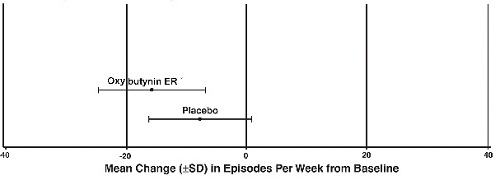
Study 2 n Oxybutynin ER n oxybutynin Mean Baseline 53 27.6 52 23.0 Mean (SD) Change from Baseline + 53 -17.6 (11.9) 52 -19.4 (11.9) 95% Confidence Interval for Difference (-2.8, 6.5) (Oxybutynin ER - oxybutynin) +Covariate adjusted mean with missing observations set to baseline values
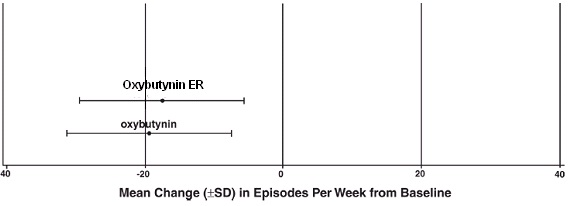
Study 3 n Oxybutynin ER n oxybutynin Mean Baseline 111 18.9 115 19.5 Mean (SD) Change from Baseline + 111 -14.5 (8.7) 115 -13.8 (8.6) 95% Confidence Interval for Difference (-3.0, 1.6) ** (Oxybutynin ER - oxybutynin) +Covariate adjusted mean with missing observations set to baseline values>
**The difference between Oxybutynin ER and oxybutynin fulfilled the criteria for comparable efficacy.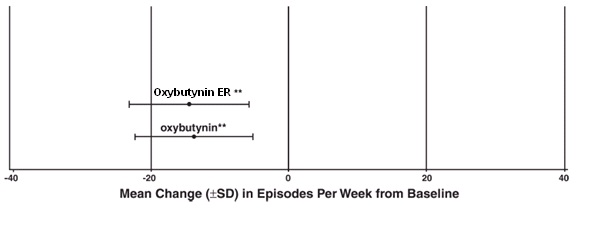
-
16 HOW SUPPLIED/STORAGE AND HANDLING
Oxybutynin chloride extended-release tablets, USP are available in three dosage strengths, 5 mg (pale yellow), 10 mg (pink), and 15 mg (grey) and are imprinted on one side with "EM1", "EM2", or "EM3" with black ink. Oxybutynin chloride extended-release tablets, USP are supplied in bottles of 30, 100, 500 and 1,000 tablets.
5 mg 30 count bottle
100 count bottle
500 count bottle
1,000 count bottleNDC: 16729-317-10
NDC: 16729-317-01
NDC: 16729-317-16
NDC: 16729-317-1710 mg 30 count bottle
100 count bottle
500 count bottle
1,000 count bottleNDC: 16729-318-10
NDC: 16729-318-01
NDC: 16729-318-16
NDC: 16729-318-1715 mg 30 count bottle
100 count bottle
500 count bottle
1,000 count bottleNDC: 16729-319-10
NDC: 16729-319-01
NDC: 16729-319-16
NDC: 16729-319-17 -
17 PATIENT COUNSELING INFORMATION
- Patients should be informed that oxybutynin may produce angioedema that could result in life threatening airway obstruction. Patients should be advised to promptly discontinue oxybutynin therapy and seek immediate medical attention if they experience swelling of the tongue, edema of the laryngopharynx, or difficulty breathing.
- Patients should be informed that anticholinergic (antimuscarinic) agents such as oxybutynin chloride extended-release tablets, may produce clinically significant adverse reactions related to anticholinergic activity such as:
- Urinary retention and constipation
- Heat prostration due to decreased sweating. Heat prostration can occur when anticholinergic medicines are administered in the presence of high environmental temperature.
- Patients should be informed that anticholinergic medicines such as oxybutynin chloride extended-release tablets may produce drowsiness (somnolence), dizziness or blurred vision. Patients should be advised to exercise caution in decisions to engage in potentially dangerous activities until oxybutynin chloride extended-release tablets effects have been determined.
- Patients should be informed that alcohol may enhance the drowsiness caused by anticholinergic agents such as oxybutynin chloride extended-release tablets.
- Patients should be informed that oxybutynin chloride extended-release tablets should be swallowed whole with the aid of liquids. Patients should not chew, divide, or crush tablets.
- Oxybutynin chloride extended-release tablets should be taken at approximately the same time each day.
-
SPL UNCLASSIFIED SECTION
For more information, go to www.accordhealthcare.us or call Accord Healthcare Inc. at 1-866-941-7875.
Manufactured For:
Accord Healthcare, Inc.,
1009 Slater Road,
Suite 210-B,
Durham, NC 27703,
USA.Manufactured By:
Intas Pharmaceuticals Limited,
Plot No. : 457, 458,
Village – Matoda,
Bavla Road, Ta.- Sanand,
Dist.- Ahmedabad – 382 210,
INDIA.10 1091 1 697321
Issued May 2019
- PRINCIPAL DISPLAY PANEL
-
INGREDIENTS AND APPEARANCE
OXYBUTYNIN CHLORIDE
oxybutynin chloride tablet, extended releaseProduct Information Product Type HUMAN PRESCRIPTION DRUG Item Code (Source) NDC: 16729-317 Route of Administration ORAL Active Ingredient/Active Moiety Ingredient Name Basis of Strength Strength OXYBUTYNIN CHLORIDE (UNII: L9F3D9RENQ) (OXYBUTYNIN - UNII:K9P6MC7092) OXYBUTYNIN CHLORIDE 5 mg Inactive Ingredients Ingredient Name Strength SILICON DIOXIDE (UNII: ETJ7Z6XBU4) HYPROMELLOSE 2208 (100000 MPA.S) (UNII: VM7F0B23ZI) HYPROMELLOSE 2910 (6 MPA.S) (UNII: 0WZ8WG20P6) LACTOSE MONOHYDRATE (UNII: EWQ57Q8I5X) MAGNESIUM STEARATE (UNII: 70097M6I30) METHACRYLIC ACID - ETHYL ACRYLATE COPOLYMER (1:1) TYPE A (UNII: NX76LV5T8J) CELLULOSE, MICROCRYSTALLINE (UNII: OP1R32D61U) POLYETHYLENE GLYCOL 400 (UNII: B697894SGQ) SODIUM BICARBONATE (UNII: 8MDF5V39QO) SODIUM LAURYL SULFATE (UNII: 368GB5141J) TALC (UNII: 7SEV7J4R1U) TITANIUM DIOXIDE (UNII: 15FIX9V2JP) TRIETHYL CITRATE (UNII: 8Z96QXD6UM) FERRIC OXIDE YELLOW (UNII: EX438O2MRT) FERRIC OXIDE RED (UNII: 1K09F3G675) Product Characteristics Color yellow (pale yellow) Score no score Shape ROUND Size 7mm Flavor Imprint Code EM1 Contains Packaging # Item Code Package Description Marketing Start Date Marketing End Date 1 NDC: 16729-317-10 30 in 1 BOTTLE; Type 0: Not a Combination Product 01/01/2022 2 NDC: 16729-317-01 100 in 1 BOTTLE; Type 0: Not a Combination Product 12/14/2016 3 NDC: 16729-317-16 500 in 1 BOTTLE; Type 0: Not a Combination Product 03/30/2017 4 NDC: 16729-317-17 1000 in 1 BOTTLE; Type 0: Not a Combination Product 01/01/2022 Marketing Information Marketing Category Application Number or Monograph Citation Marketing Start Date Marketing End Date ANDA ANDA207138 12/14/2016 OXYBUTYNIN CHLORIDE
oxybutynin chloride tablet, extended releaseProduct Information Product Type HUMAN PRESCRIPTION DRUG Item Code (Source) NDC: 16729-318 Route of Administration ORAL Active Ingredient/Active Moiety Ingredient Name Basis of Strength Strength OXYBUTYNIN CHLORIDE (UNII: L9F3D9RENQ) (OXYBUTYNIN - UNII:K9P6MC7092) OXYBUTYNIN CHLORIDE 10 mg Inactive Ingredients Ingredient Name Strength POLYETHYLENE GLYCOL 400 (UNII: B697894SGQ) SODIUM BICARBONATE (UNII: 8MDF5V39QO) SODIUM LAURYL SULFATE (UNII: 368GB5141J) TALC (UNII: 7SEV7J4R1U) TITANIUM DIOXIDE (UNII: 15FIX9V2JP) TRIETHYL CITRATE (UNII: 8Z96QXD6UM) FERRIC OXIDE YELLOW (UNII: EX438O2MRT) FERRIC OXIDE RED (UNII: 1K09F3G675) SILICON DIOXIDE (UNII: ETJ7Z6XBU4) HYPROMELLOSE 2208 (100000 MPA.S) (UNII: VM7F0B23ZI) HYPROMELLOSE 2910 (6 MPA.S) (UNII: 0WZ8WG20P6) LACTOSE MONOHYDRATE (UNII: EWQ57Q8I5X) MAGNESIUM STEARATE (UNII: 70097M6I30) METHACRYLIC ACID - ETHYL ACRYLATE COPOLYMER (1:1) TYPE A (UNII: NX76LV5T8J) CELLULOSE, MICROCRYSTALLINE (UNII: OP1R32D61U) Product Characteristics Color pink Score no score Shape ROUND Size 7mm Flavor Imprint Code EM2 Contains Packaging # Item Code Package Description Marketing Start Date Marketing End Date 1 NDC: 16729-318-10 30 in 1 BOTTLE; Type 0: Not a Combination Product 01/01/2022 2 NDC: 16729-318-01 100 in 1 BOTTLE; Type 0: Not a Combination Product 12/20/2016 3 NDC: 16729-318-16 500 in 1 BOTTLE; Type 0: Not a Combination Product 04/17/2017 4 NDC: 16729-318-17 1000 in 1 BOTTLE; Type 0: Not a Combination Product 01/01/2022 Marketing Information Marketing Category Application Number or Monograph Citation Marketing Start Date Marketing End Date ANDA ANDA207138 12/20/2016 OXYBUTYNIN CHLORIDE
oxybutynin chloride tablet, extended releaseProduct Information Product Type HUMAN PRESCRIPTION DRUG Item Code (Source) NDC: 16729-319 Route of Administration ORAL Active Ingredient/Active Moiety Ingredient Name Basis of Strength Strength OXYBUTYNIN CHLORIDE (UNII: L9F3D9RENQ) (OXYBUTYNIN - UNII:K9P6MC7092) OXYBUTYNIN CHLORIDE 15 mg Inactive Ingredients Ingredient Name Strength SILICON DIOXIDE (UNII: ETJ7Z6XBU4) HYPROMELLOSE 2208 (100000 MPA.S) (UNII: VM7F0B23ZI) HYPROMELLOSE 2910 (6 MPA.S) (UNII: 0WZ8WG20P6) LACTOSE MONOHYDRATE (UNII: EWQ57Q8I5X) MAGNESIUM STEARATE (UNII: 70097M6I30) METHACRYLIC ACID - ETHYL ACRYLATE COPOLYMER (1:1) TYPE A (UNII: NX76LV5T8J) CELLULOSE, MICROCRYSTALLINE (UNII: OP1R32D61U) POLYETHYLENE GLYCOL 400 (UNII: B697894SGQ) SODIUM BICARBONATE (UNII: 8MDF5V39QO) SODIUM LAURYL SULFATE (UNII: 368GB5141J) TALC (UNII: 7SEV7J4R1U) TITANIUM DIOXIDE (UNII: 15FIX9V2JP) TRIETHYL CITRATE (UNII: 8Z96QXD6UM) FERRIC OXIDE YELLOW (UNII: EX438O2MRT) FERROSOFERRIC OXIDE (UNII: XM0M87F357) Product Characteristics Color gray Score no score Shape ROUND Size 7mm Flavor Imprint Code EM3 Contains Packaging # Item Code Package Description Marketing Start Date Marketing End Date 1 NDC: 16729-319-10 30 in 1 BOTTLE; Type 0: Not a Combination Product 01/01/2022 2 NDC: 16729-319-01 100 in 1 BOTTLE; Type 0: Not a Combination Product 12/14/2016 3 NDC: 16729-319-16 500 in 1 BOTTLE; Type 0: Not a Combination Product 01/01/2022 4 NDC: 16729-319-17 1000 in 1 BOTTLE; Type 0: Not a Combination Product 01/01/2022 Marketing Information Marketing Category Application Number or Monograph Citation Marketing Start Date Marketing End Date ANDA ANDA207138 12/14/2016 Labeler - Accord Healthcare, Inc. (604222237) Registrant - Accord Healthcare, Inc. (604222237) Establishment Name Address ID/FEI Business Operations Intas Pharmaceuticals Limited 725927649 manufacture(16729-317, 16729-318, 16729-319) , analysis(16729-317, 16729-318, 16729-319)
© 2025 FDA.report
This site is not affiliated with or endorsed by the FDA.
